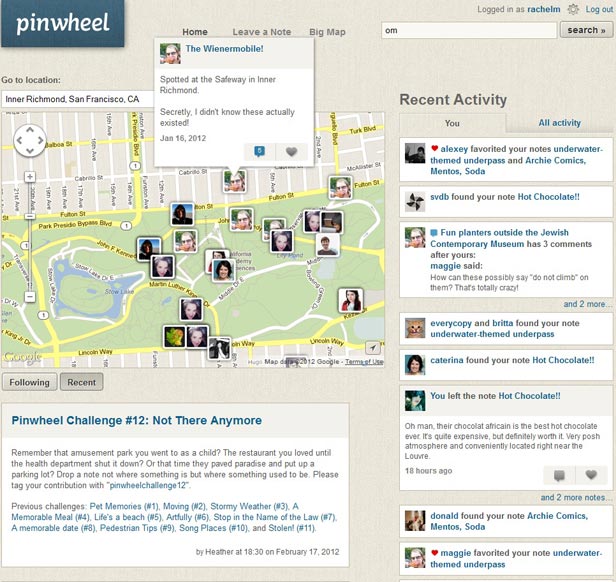Exploring the World, Note by Note

You’ve probably left plenty of notes for people in the past—on a kitchen counter, slipped through the slots of a locker, or even scrawled on a bathroom wall. But what if you could leave notes anywhere in the world for anyone to discover, and find ones posted by others?
That’s the idea behind Pinwheel, the latest startup from Flickr cofounder Caterina Fake. Though the social site only recently emerged in a private beta testing phase, it’s gaining buzz for its simple premise: letting people annotate a map with notes on any topic that can be shared with others.
Fake, a fan of the GPS treasure-hunting activity known as geocaching, says Pinwheel merges several ideas and inspirations. She first began toying with the idea of leaving virtual notes for others to find back in 1999, but the technology wasn’t there to support it. And after cofounding Flickr in 2004, she was inspired by users of that site who would annotate satellite maps of their hometowns with notes about various locations. Now, as smart phones have become incredibly popular and location-based apps like Foursquare have blossomed, Fake is confident that the timing is right for Pinwheel, too.
The site’s main page—which you need an invitation to see—shows a stream of recently posted notes, and users can browse a map there to check out public notes, leave notes, or search for notes or users.
Navigating the main map is like exploring a visual mash-up of a travel and restaurant guide peppered with memories of first kisses and apartments, event notices, historical facts, and more. There are burger and sushi recommendations, notes about good places to watch the sun set, and tags marking a long-gone movie theater and candy store. One user has been using Pinwheel to log crimes—including the kidnapping and return of Banana Sam, a squirrel monkey belonging to the San Francisco Zoo (now safely returned)—while another is recording historic facts in various cities.
“To me, when you are creating social software, the most exciting part of it is when people start using your tools for things you hadn’t expected,” Fake says.
At the moment, there is no Pinwheel smart-phone app to help you leave notes on the fly, so users simply log on to the Pinwheel website to do so (there is a mobile site, and Fake says an iPhone app is forthcoming).
Notes can be set as visible to any site user, or just to certain people that you’ve chosen to follow on the site. Currently, notes can only include text or photos, but Fake says this could eventually expand to audio or video clips as well.
As of early last week, only about 1,000 people were using the site, but Fake says tens of thousands of people have requested invites, and Pinwheel is now sending those out.
Jason Hong, an associate professor at Carnegie Mellon University who studies mobile social technology, sees interesting possibilities for Pinwheel as well as several challenges, including how to gain a critical mass of users and content given the popularity of existing tools like Yelp, Foursquare, and Twitter. “People are still struggling with what, exactly, they’re using this for,” he says.
Regardless, investors are confident Pinwheel is on to something. The site recently raised $7.5 million in a Series A funding round led by Redpoint Ventures, which added to the $2 million in funding Pinwheel had previously raised. Fake’s past success helped, too—photo-sharing site Flickr sold to Yahoo in 2005 and the recommendation engine Hunch, which she also cofounded, sold to eBay in 2011, both for undisclosed amounts.
And, unlike many other Silicon Valley startups, Pinwheel does have a business model: it plans to make money by allowing sponsored notes, something that it’s already testing out.
Redpoint partner Geoff Yang says he liked the notion of bringing an offline activity like leaving notes onto the Web, and he sees the site as the combination of social, mobile, and local trends. “I thought the idea was really interesting—the notion that Pinwheel, in many respects, makes places come alive,” he says.
Keep Reading
Most Popular
Large language models can do jaw-dropping things. But nobody knows exactly why.
And that's a problem. Figuring it out is one of the biggest scientific puzzles of our time and a crucial step towards controlling more powerful future models.
The problem with plug-in hybrids? Their drivers.
Plug-in hybrids are often sold as a transition to EVs, but new data from Europe shows we’re still underestimating the emissions they produce.
How scientists traced a mysterious covid case back to six toilets
When wastewater surveillance turns into a hunt for a single infected individual, the ethics get tricky.
Google DeepMind’s new generative model makes Super Mario–like games from scratch
Genie learns how to control games by watching hours and hours of video. It could help train next-gen robots too.
Stay connected
Get the latest updates from
MIT Technology Review
Discover special offers, top stories, upcoming events, and more.